Must-See Ancient Theaters in Turkey: A Journey Through History
Turkey is full of unique historical buildings where you can trace thousands of years of civilisations. Especially ancient theatres shed light on Anatolia's past with their magnificent architecture and the cultural heritage they carry. These open-air structures, dating back to the Hellenistic and Roman periods, are fascinating travel routes not only for history buffs but also for nature and art enthusiasts.
In this article, we introduce the 10 must-see ancient theatres in Turkey in detail and offer you a guide to explore each building with its historical significance, architectural features, legends and transportation information. If you are looking for the best preserved ancient theatres in Turkey, an ancient cities tour, or cultural travel routes, you are in the right place.
1. Aspendos Ancient Theatre (Antalya - Serik)
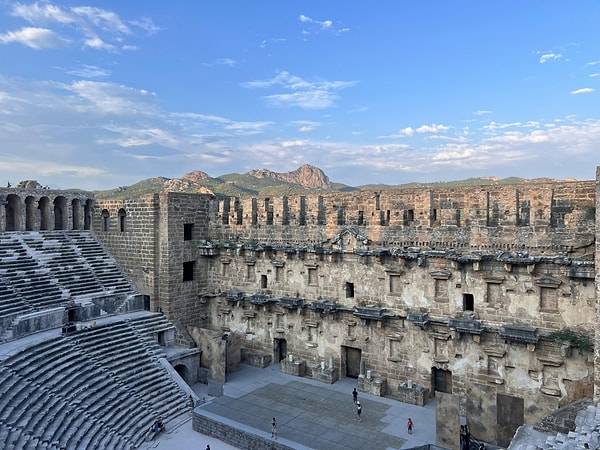
The Aspendos Theatre, one of the engineering wonders of the ancient period, is considered the most successful example of Roman architecture in Anatolia. It was built by the architect Zenon in the 2nd century AD, during the reign of Emperor Marcus Aurelius.
Highlights:
It is a gigantic structure with a seating capacity of approximately 15,000-20,000 people.
It is famous for its excellent acoustics. Even if the stage is spoken in a whisper, it can be heard by the whole theatre.
The theatre stage has three floors and the reliefs on it depict mythological scenes.
The aqueducts next to it indicate the advanced engineering system in the ancient city.
Cultural Importance:
Aspendos was not only a theatre but also a public meeting point. Gladiator fights, religious ceremonies, and senate meetings were held here. According to the legend, the architect Zenon, who built the theatre, competed with his brother to get the king's daughter; the king preferred Zenon when he admired the acoustics of the theatre.
Transportation:
It is about 45 km from Antalya city centre. It is possible to reach Belkıs Village in Serik district by minibuses or private car. Aspendos direction signs are quite prominent along the way.
2. Ephesus Ancient Theatre (Izmir - Selcuk)
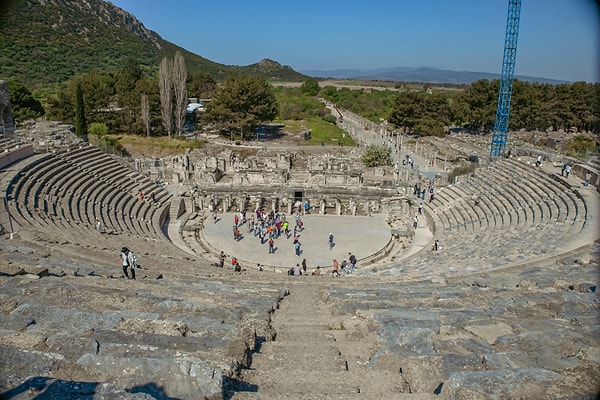
Located in the heart of the ancient city of Ephesus, a UNESCO World Heritage Site, this theatre is notable not only for its architecture but also for its religious and social functions throughout history. Built in the Hellenistic style in the 3rd century BC, it was enlarged during the Roman period to accommodate approximately 25,000 people.
Prominent Features:
The seating areas of the theatre are made of marble.
The stage building has three floors and bears the characteristics of Roman architecture with its arcaded structure.
There were statues dedicated to the gods in the niches on the stage wall.
Its acoustics are very strong and it is still used for concerts.
Historical Importance:
Ephesus Theatre is also known as the place where St. Paulus (St. Paul) gave his sermons on Christianity. In this respect, it is an important place not only culturally but also religiously. It was also used for gladiator fights and dramatic plays.
Transport:
You can reach Selçuk from Izmir by train, bus or private car. It is possible to go from Selçuk to the ancient city of Ephesus by minibuses or taxis. There are also regular tours to Ephesus in the summer months.
3. Pergamon Ancient Theatre (Izmir - Bergama)
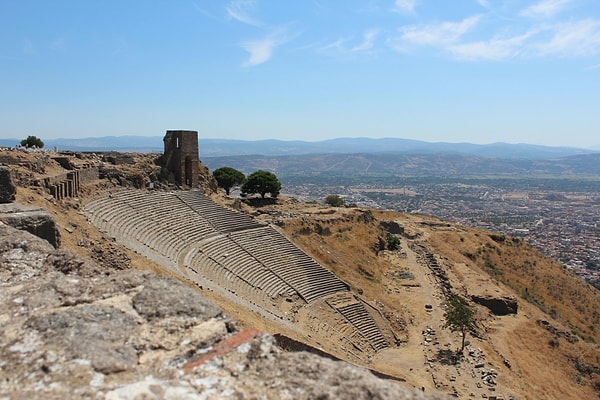
The ancient city of Pergamon (Bergama) was the cultural and scientific capital of Anatolia during the Hellenistic period. The most remarkable structure of the city is the 10,000-seat Pergamon Theatre. It was built on the acropolis slope with extraordinary engineering.
Prominent Features:
It is the steepest sloping ancient theatre in the world.
It has 80 seating rows.
The remains of the stage building and the temple underneath can still be seen.
The breathtaking view of the Bakırçay Plain can be seen from the theatre.
Cultural Importance:
The theatre was used not only for entertainment purposes but also for political meetings and religious ceremonies. In addition, when considered together with the Asclepion health centre in the city, the theatre was also a part of spiritual purification.
Transport:
You can reach Bergama from Izmir by bus or private car in about 1.5 hours. It is possible to go up to the Acropolis from the city centre by cable car or on foot.
4. Hierapolis Ancient Theatre (Denizli - Pamukkale)
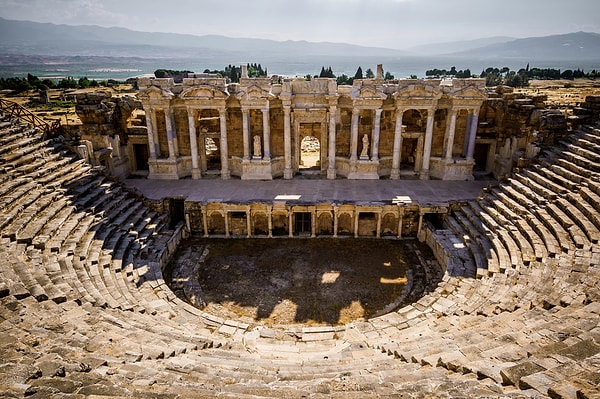
This theatre, integrated with the white travertines of Pamukkale, attracts attention not only with its view but also with its unique reliefs. The construction started in the 1st century AD and was completed in the 3rd century AD.
Prominent Features:
It has a capacity of approximately 12,000 people.
The stage building has reliefs depicting Apollo's music competitions.
It is one of the best preserved stage decorations of the ancient period.
Cultural Importance:
The theatre was at the centre of the cultural and religious life of the ancient city of Hierapolis. The theatre was also a social centre for visitors to the healing waters.
Transportation:
Pamukkale can be reached by minibus or private car from Denizli centre in 20-25 minutes. The theatre is located just above the Pamukkale travertines and can be reached on foot.
5. Bodrum Ancient Theatre (Muğla - Halicarnassos)
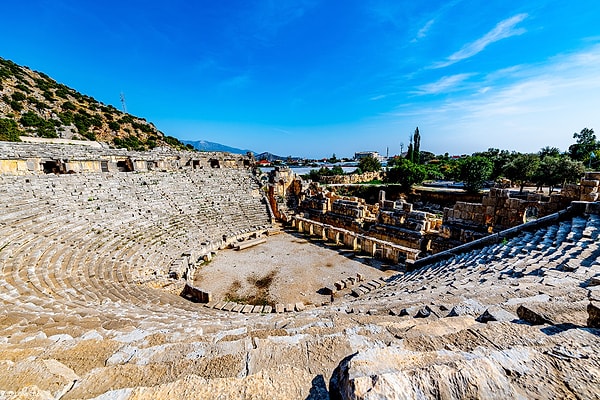
Dating back to the 4th century BC, the Ancient Theatre of Halicarnassos (Bodrum) was built during the reign of King Mausolos and expanded during the Roman period.
Highlights:
13,000 capacity.
The foundations of the stage building can still be seen.
It is used for the Bodrum Ballet Festival and concerts in the summer months.
Cultural Significance:
The theatre marks the Hellenistic origins of Bodrum. It also offers an excellent panorama of the city, overlooking Bodrum Castle and the ancient harbour.
Transport:
Bodrum city centre can be reached on foot in 10 minutes. Since the theatre is located on the main road, it is also very easy to access by public transport.
Source: Rab Lawrence
6. Antiphellos Ancient Theatre (Antalya - Kas)
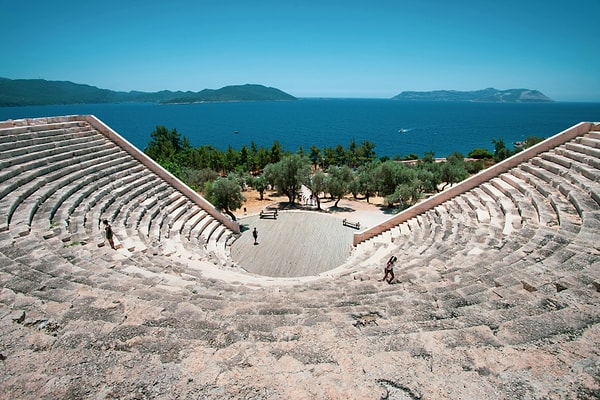
Antiphellos (today Kas), one of the important cities of Lycia, has a small but impressive ancient theatre. It is estimated to have been built in the 1st century BC.
Prominent Features:
It has a capacity of approximately 4,000 people.
The theatre was built completely facing the sea.
The orchestra part is built with smooth stones.
Cultural Importance:
This theatre exhibits the modest but elegant architecture of the Lycian civilisation. Sitting here at sunrise and sunset offers the visitor a unique experience that combines history and meditation.
Transport:
It can be reached on foot in 10-15 minutes from the Kas district centre. Directional signs in the city centre guide visitors.
7. Aphrodisias Ancient Theatre (Aydin - Karacasu)
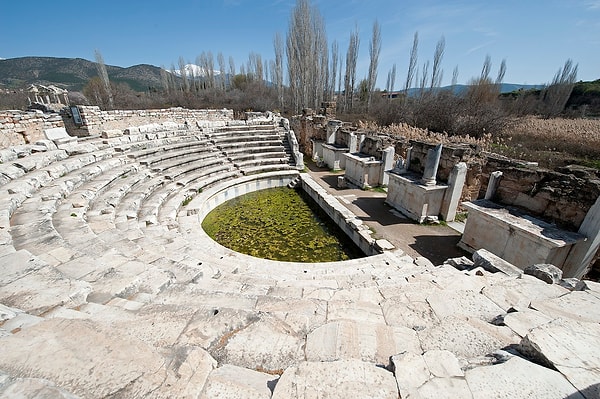
The ancient city of Aphrodisias is named after Aphrodite, the goddess of love and beauty, and is located in the Karacasu district of Aydin. The city is known as one of the important art and culture centres of the ancient world. The ancient theatre in Aphrodisias, which is especially famous for its sculpture school, is one of the most magnificent examples of the architectural elegance of the city.
Historical and Architectural Features:
It dates back to the 1st century BC; it underwent major restorations during the Roman period.
It has a capacity of approximately 8.000 people.
The theatre stage (scaenae frons) had a magnificent three-storey facade and its decorations included statues of gods, mythological reliefs and inscriptions.
The lower part of the theatre (orchestra) was later converted into an arena-like structure and hosted gladiatorial fights.
Cultural Importance:
The Aphrodisias Theatre reflects the artistic spirit of the city. Not only dramatic plays, but also political speeches, religious ceremonies and public meetings were held here. The sculptures in the background of the theatre contain scenes from the cult of Aphrodite and give important clues about the aesthetic understanding of the period.
Transportation:
It is approximately 90 km to the Aydın city centre. You can reach Karacasu district via Nazilli, the nearest large district, and from there you can reach Aphrodisias Ancient City by following the roads directed by signposts. Travelling by private car is the most comfortable option; public transport is limited.
Source: By Dosseman
8. Ancient Theatre of Priene (Aydın - Söke)
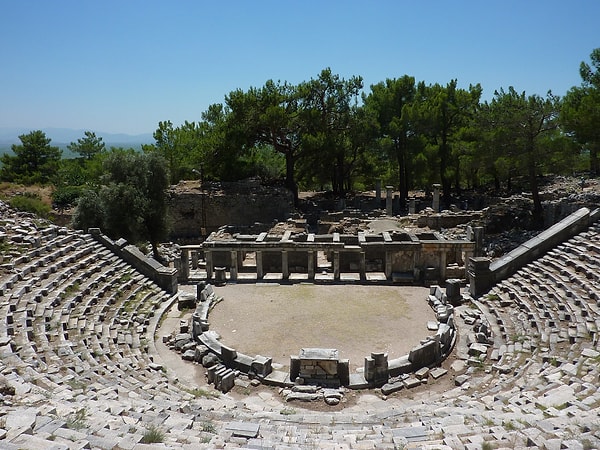
Priene, built on a hill overlooking the old bed of the Menderes River, offers one of the best examples of ancient city planning. The ancient theatre in the city was built by adhering to this geometric order and is one of the most characteristic theatres of the Hellenistic period.
Architectural and Historical Features:
It dates back to the 4th century BC and was built entirely in Hellenistic style.
It has a capacity of approximately 6,500 people.
Five VIP seats are still intact in the theatre. Behind these seats are the names of high-ranking city officials.
The orchestra and stage building are very well preserved; the original plan of the building can be clearly traced.
Cultural Importance:
The Theatre of Priene served not only as a place of entertainment but also as a centre for city government. Public assembly meetings were held here. By establishing a spatial relationship with the Temple of Demeter near the theatre, both religious and secular functions were carried out together.
Transport
The ancient city of Priene is approximately 15 km away from the Söke district of Aydın. When you head towards Güllübahçe village from Söke, you will be guided by the signs of the ancient city. The last part of the road is a bit rough; comfortable shoes are recommended for walking.
Source: By Adrian Farwell
9. Ancient Theatre of Miletus (Aydın - Didim)
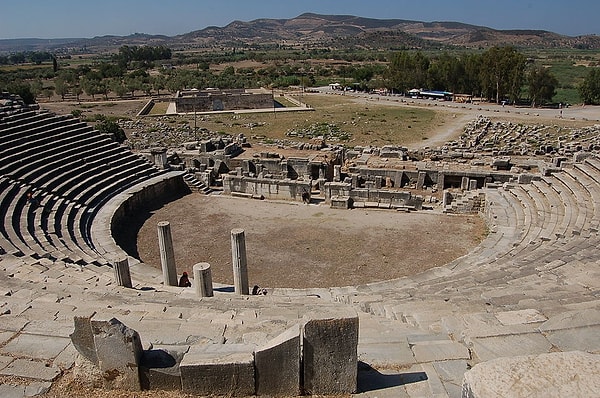
Miletus, one of the most important port cities of antiquity, is considered the cradle of science and philosophy. The ancient theatre in this city, where philosophers such as Thales, Anaximandros and Anaximenes were born, attracts attention with its historical context and architectural grandeur.
Architectural Features:
Built in the 3rd century BC in Hellenistic style, it was largely rebuilt during the Roman period and reached a capacity of 15,000 people.
The theatre was built with a three-tiered cavea (seating row) system.
The lower structure was reinforced with vaults and these sections can still be visited today.
The stage building was multi-storeyed and was once used as a Byzantine fortress.
Cultural and Historical Importance:
The Miletus Theatre served as a forum not only for performances but also for political, religious and economic decisions. In addition, the inscriptions and figures in the stage building of the theatre give important clues about the social structure of the ancient city.
Transport
The ancient city of Miletus is approximately 25 km from Didim and 100 km from Aydın. It is possible to reach the ancient city via Güllübahçe by minibuses departing from Didim and Söke. It is recommended to go by private car in order to travel comfortably in the region.
10. Termessos Ancient Theatre (Antalya - Güllük Mountain National Park)
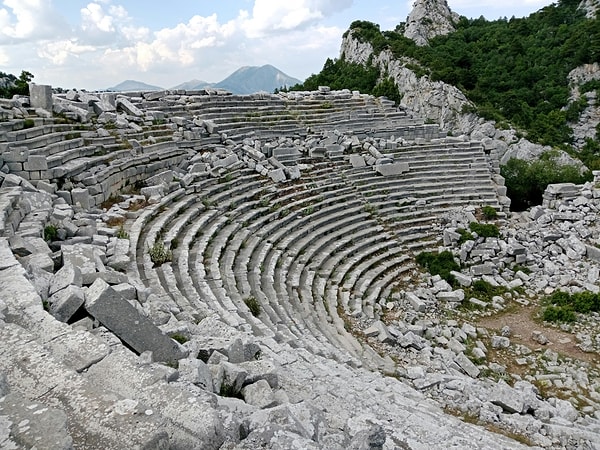
Termessos is a fascinating ancient city with both nature and history. Located at the foothills of the Taurus Mountains at an altitude of over 1,000 metres, the city is one of the rare settlements that even Alexander the Great could not conquer. This isolated location has enabled its theatre to be integrated with a unique landscape.
Architectural and Natural Features:
It has a capacity of approximately 4,000-5,000 people.
The theatre was built in harmony with the natural slope of the mountain.
The seating rows are still intact and the view of the Gulf of Antalya and Bey Mountains can be seen from the theatre.
Although the stage building has been largely destroyed, the orchestra and cavea are in good condition.
Cultural and Historical Importance:
The theatre of Termessos is the symbol of freedom of the Pisidian peoples. The city had its own administrative system and the theatre was both the cultural and political centre of this structure. Today, it still gives its visitors the feeling that time has stopped with its structure in the middle of nature, in complete silence.
Transport:
You can reach Termessos from Antalya by private car, approximately 35 km to the entrance of Termessos National Park on Güllük Mountain. After the entrance, it requires a 9 km mountain road and then a pedestrian climb of about 30-45 minutes. The track is challenging; therefore, suitable footwear and water should be brought with you.
Keşfet ile ziyaret ettiğin tüm kategorileri tek akışta gör!

Send Comment